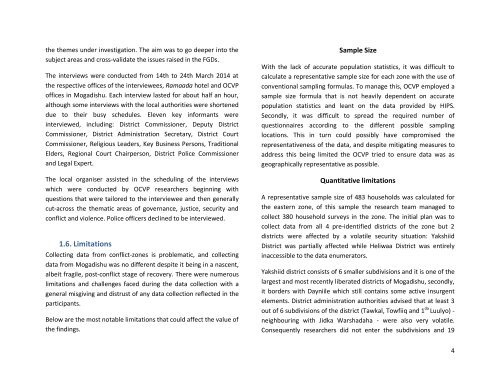Eastern Zone DCSA
Eastern Zone DCSA
Eastern Zone DCSA
Create successful ePaper yourself
Turn your PDF publications into a flip-book with our unique Google optimized e-Paper software.
the themes under investigation. The aim was to go deeper into the<br />
subject areas and cross-validate the issues raised in the FGDs.<br />
The interviews were conducted from 14th to 24th March 2014 at<br />
the respective offices of the interviewees, Ramaada hotel and OCVP<br />
offices in Mogadishu. Each interview lasted for about half an hour,<br />
although some interviews with the local authorities were shortened<br />
due to their busy schedules. Eleven key informants were<br />
interviewed, including: District Commissioner, Deputy District<br />
Commissioner, District Administration Secretary, District Court<br />
Commissioner, Religious Leaders, Key Business Persons, Traditional<br />
Elders, Regional Court Chairperson, District Police Commissioner<br />
and Legal Expert.<br />
The local organiser assisted in the scheduling of the interviews<br />
which were conducted by OCVP researchers beginning with<br />
questions that were tailored to the interviewee and then generally<br />
cut-across the thematic areas of governance, justice, security and<br />
conflict and violence. Police officers declined to be interviewed.<br />
1.6. Limitations<br />
Collecting data from conflict-zones is problematic, and collecting<br />
data from Mogadishu was no different despite it being in a nascent,<br />
albeit fragile, post-conflict stage of recovery. There were numerous<br />
limitations and challenges faced during the data collection with a<br />
general misgiving and distrust of any data collection reflected in the<br />
participants.<br />
Below are the most notable limitations that could affect the value of<br />
the findings.<br />
Sample Size<br />
With the lack of accurate population statistics, it was difficult to<br />
calculate a representative sample size for each zone with the use of<br />
conventional sampling formulas. To manage this, OCVP employed a<br />
sample size formula that is not heavily dependent on accurate<br />
population statistics and leant on the data provided by HIPS.<br />
Secondly, it was difficult to spread the required number of<br />
questionnaires according to the different possible sampling<br />
locations. This in turn could possibly have compromised the<br />
representativeness of the data, and despite mitigating measures to<br />
address this being limited the OCVP tried to ensure data was as<br />
geographically representative as possible.<br />
Quantitative limitations<br />
A representative sample size of 483 households was calculated for<br />
the eastern zone, of this sample the research team managed to<br />
collect 380 household surveys in the zone. The initial plan was to<br />
collect data from all 4 pre-identified districts of the zone but 2<br />
districts were affected by a volatile security situation: Yakshiid<br />
District was partially affected while Heliwaa District was entirely<br />
inaccessible to the data enumerators.<br />
Yakshiid district consists of 6 smaller subdivisions and it is one of the<br />
largest and most recently liberated districts of Mogadishu, secondly,<br />
it borders with Dayniile which still contains some active insurgent<br />
elements. District administration authorities advised that at least 3<br />
out of 6 subdivisions of the district (Tawkal, Towfiiq and 1 da Luulyo) -<br />
neighbouring with Jidka Warshadaha - were also very volatile.<br />
Consequently researchers did not enter the subdivisions and 19<br />
4


